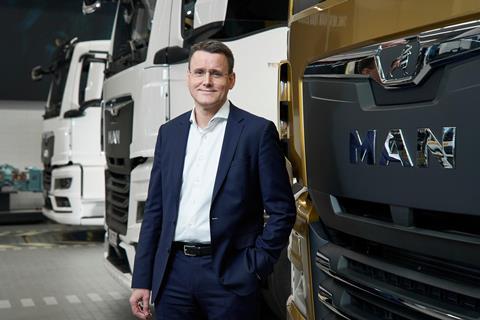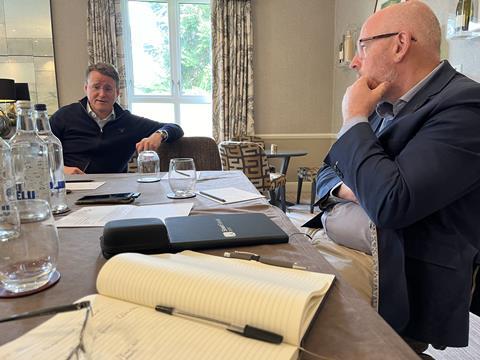There’s been a flurry of announcements from MAN Truck & Bus recently on its zero-emission vehicles, so when we got wind that the company CEO, Alexander Vlaskamp, was in the UK, we had to secure an exclusive interview. Andy Salter tracked him down.

While the likes of DAF, Volvo, Daimler, Renault and Scania had been quick out of the traps with their zero-emission vehicle strategies, we were getting mildly concerned MAN was getting left behind. We need not have worried. Recent announcements on the development of the range, a burgeoning forward order book for its new eTruck and a commitment to launching a small series of trucks powered by hydrogen internal combustion engines, indicates MAN is joining the decarbonisation party and means business.
“The UK is a very important market for us and we will use the same solution, both in the EU and UK. I was a bit surprised about the harsh abandonment of internal combustion engines by the UK. I can only recommend any new government looks into that and maybe follows the more pragmatic principles and direction which have been adopted by the EU.”
Alexander Vlaskamp is CEO of MAN Truck & Bus and was over in the UK in May, with other members of the team from the Munich headquarters, to meet customers and understand how operators in MAN’s third biggest European market see the future. In our short 30-minute session with him, we were keen to understand his thoughts on the developing legislative framework for low- and zero-emission vehicles across Europe, and how this might impact the UK.
“The legislator does, of course, have quite a push on the OEMs,” he explains, referring to our initial observation that the policy makers in Europe and here in the UK, seem to be pushing the burden for the introduction of low- and zero-carbon vehicles onto the vehicle suppliers, with little attention given to the demand side of the equation. “From an EU regulatory point of view, there are two clear key decisions which have now been made,” he continues. “Firstly, Euro-7, now agreed for implementation in mid-2029. The required emissions levels, to satisfy that regulation, are now reasonable, as are the test cycles. Euro-7 is technically feasible without driving too much investment for the OEMs or the customers who will be buying the vehicles.
“The other regulatory decision is the CO2 regulation, which sets the expected reduction in carbon emission by 2030. This has been increased from a 30% reduction, compared to 2019 levels, to 45%. Now here comes the UK’s deviation, which still has the ‘old’ EU target of a 30% reduction in carbon emissions by 2030, topped up with the abandonment of the combustion engine.” More of which later.
“The EU and society in general are taking CO2 seriously, everybody is committed to the Paris Agreement, including us, but we see the pricing for using carbon-based fuels, is still too low. This will not drive our customers and their customers, the consumers, to understand they have to pay for this transition [to a net zero future]. The transition will have a peak, which will have to be paid for. As the infrastructure improves, we will get scale and then the cost levels [for zero-emission vehicles] will come down closer to what we know today.”

While the recent swing in politics in the European parliamentary election may have weakened the prospect of any increased taxation on fossil fuels, in the short term, this is clearly a lever that is open to politicians if they want to accelerate the pace of decarbonisation. For Vlaskamp, however, there are further ingredients which need to be put in place before the sector is primed for decarbonisation take-off. He calls this the magic formula: “The key parts of the formula are trucks, infrastructure and energy, and there has to be [favourable] TCO (total cost of operation)” he says. “We have the trucks ready to go, but the trucks need infrastructure and the infrastructure requires energy, which has to be renewable. The energy we consume has to be green.
“The EU and society in general are taking CO2 seriously, everybody is committed to the Paris Agreement, including us, but we see the pricing for using carbon-based fuels, is still too low. This will not drive our customers and their customers, the consumers, to understand they have to pay for this transition [to a net zero future]. The transition will have a peak, which will have to be paid for. As the infrastructure improves, we will get scale and then the cost levels [for zero-emission vehicles] will come down closer to what we know today.”
“The big challenge on infrastructure is the grid and the connection to that grid. Here we need both the utility companies, who are busy trying to facilitate a lot of other connections, and of course, we need the regulators. Governments are acknowledging they have to invest in the grid and in Europe this is supported by the AFI (Alternative Fuels Infrastructure) Regulation. As manufacturers, we have to build up the new trucks, and if we don’t deliver, we get fined. But the AFI Regulation, which describes that the member states must build up the infrastructure, has no penalties. This [the development of infrastructure] is where we see a bottleneck going forward.”
Having discussed the success factors of trucks and energy infrastructure, Vlaskamp, brings in his third part of the formula for the acceleration to zero-emission vehicles, TCO , and to be more precise, TCO parity with diesel: “In the end, it boils down to the delta between running on carbons or running on electric,” he says, emphasising his previous point that there will need to be some fiscal assistance in order to push through the transitory period from diesel to zero-emission vehicles be it through fuel duty, road charging or other incentives. If any of the three parts of the formula – trucks, infrastructure and TCO – aren’t delivering, nothing will happen, he says “and that is the lock situation we see at the moment,” he adds.
While it is no doubt, frustrating, MAN is keen to play its part in the transition and has signed up to science-based targets to have “zero impact by 2050,” Vlaskamp explains. “On our Scope 1 and 2 emissions we are already well on the way.”
Scope Three emissions of a vehicle manufacturer also includes the use of the vehicle during its lifetime, he reminds us, “so in that respect we are part of the problem,” he adds, underlining how important it is for the manufacturers to facilitate the shift to net zero if they, themselves, are to satisfy their own sustainability objectives.
While he is aware of the barriers and blockages currently frustrating the speed of decarbonisation, he is optimistic things are starting to progress: “We see more and more companies signing up to the science-based targets and many of those are ordering transport, looking into their supply chains and talking to their carriers, who in turn come and talk to us and we see things starting to move,” he says.
In preparation for a net zero future, MAN, as part of the Traton Group, is invested in Milence, the joint-venture charge point operator formed with Daimler Trucks and Volvo Group to roll out a network of European public truck charging sites. “We are also preparing our dealer service points and we will soon announce that we are partnering with a large utility company in Europe to electrify our service depots,” he adds. “We are also contemplating how we can use our telematics to enable customers to share their electrified depots.”
MAN has a rich heritage in diesel engine development and while the future may be zero emission, Vlaskamp doesn’t expect the company to be dropping diesel just yet. “There are a lot of markets where it will be needed for a long time,” he explains. “Most likely diesel will prevail in applications such as heavy haulage, firefighting and military. This is where our diesel competence will remain.”
In the longer term, MAN has signalled its intent to explore hydrogen internal combustion engine vehicles for some of these difficult to decarbonise applications. “The EU policy has given us a framework that now makes this type of vehicle possible,” he continues, “but of course with hydrogen, we have to understand the cost and availability of hydrogen. We now have a vehicle to show the case for hydrogen and we have genuine market interest.”
Those countries which have been keen to promote hydrogen in their energy mix are, as expected, at the front of the queue for the first vehicles and Vlaskamp cites Norway, Netherlands, Belgium, and Germany as the four main European territories, while the Middle East is also on the radar. “We expect to deliver the first units next year,” he adds.
Obviously, we asked if the UK would be in line for any of the initial hydrogen-powered vehicles, but this seems unlikely, “so far, it doesn’t make sense for many different reasons,” he said, adding, “but I don’t think we need to run through all of them today.”
Finally, we turned the discussion to the UK market and his thoughts around the divergence of government policy in relation to low- and zero-carbon vehicles. “Of course, we have a requirement to hit the targets here in the UK as well,” he tells us. “The UK is a very important market for us and we will use the same solution, both in the EU and UK. I was a bit surprised about the harsh abandonment of internal combustion engines by the UK,” he continues. “I can only recommend any new government looks into that and maybe follows the more pragmatic principles and direction which have been adopted by the EU.”













